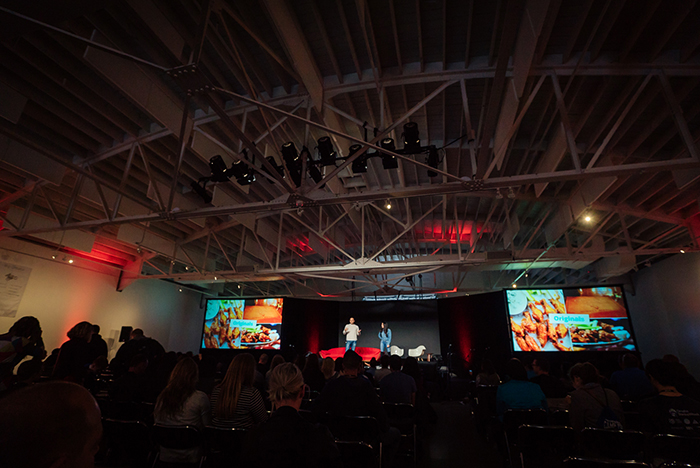
Big Omaha 2017 wrapped up on Friday at KANEKO with one last round of inspiring speakers.
Last week’s conference marked the ninth year in a row that Big Omaha brought together the region’s entrepreneurs to talk about growing businesses, overcoming hurdles and changing the tech landscape in the Silicon Prairie.
“This year exceeded all expectations. Conference goers told me that they loved the variety of speakers, the energy in the building, and the connections they made,” said Brian Lee, Big Omaha Managing Director. “We can’t wait for the 10th anniversary next year.”
The three-day conference ended with a happy hour outside KANEKO followed by a closing party at Hotel Deco.
Read the rest of our recaps to get caught up on the whole conference and check out SPN’s final recap of Friday afternoon’s speakers below.
Vanessa Torrivilla and Joe Ariel

Spouses Torrivilla and Ariel started Goldbely, a curated marketplace for gourmet food and food gifts, after Ariel posed the question: What if there were no geographical limitations to food and you could order anything you want from anywhere in the country?
“I knew I had to be a part of this,” said Torrivilla. “Our mission was to find every delicious bite in the country and make it available anywhere.”
Shortly after starting the business, Goldbely was accepted to Y Combinator and the staff of four moved to Silicon Valley. While there, Time named them one of the 50 Best Websites and their business gained thousands of followers overnight. That brought on a new set of challenges for the company.
“We needed to find stuff to sell and the sellers weren’t ready,” said Torrivilla.
Ariel stressed the importance of startups doing whatever it takes to get their supply chain going and taking on any job necessary.
“In the beginning, do things that aren’t scalable,” said Ariel
Margenett Moore-Roberts

Moore-Roberts, global head of Yahoo’s Office of Inclusive Diversity, thought her company was diversified until Yahoo released their first diversity report. The results shocked her.
“Is there where I work?” Moore-Roberts asked herself. “I didn’t realize I was working at a company that was 2% black.”
Moore-Roberts said Yahoo attempted to diversify their talents, but new hires would leave almost as soon as they were brought on. She knew there was a problem that extended beyond just hiring, not just for Yahoo, but for all companies.
“We are trying to solve this problem of diversity when it’s really about inclusivity,” said Moore-Roberts. “We cannot hire our way out of this problem.”
She said that once hired, an employee needs to be welcomed into a working environment of active inclusion––something that Yahoo now focuses on.
“When you have a seat at the table, you’ve got to pull the chair out for someone else,” said Moore-Roberts. “Invite someone else to the table.”
Nish Nadaraja and Christina Brodbeck

Nadaraja and Brodbeck have a working relationship that goes back over a decade to when they were both working at then-fledgling companies like Yelp, YouTube and Paypal. They reunited in 2010 for a project and about a year ago, started kicking around the idea of writing a book together.
“About a year ago, Christina reached out to me and asked, ‘Why don’t we do this book together,” recalled Nadaraja. “I blew her off.”
Then they got the call about speaking at Big Omaha and Nadaraja reconsidered. They began to hone their focus on everything they knew about branding and developed a series of assignments that force companies to think of their brand as a person in order to better define it.
“If your brand walked into a bar, what would its pickup line be?” asked Brodbeck.
They suggested business owners ask people who aren’t their customers what they think of the brand. They also emphasized the need for a good story behind a brand because without a story, a brand is just a commodity.
“You can’t spell culture without cult,” said Nadaraja.
Mona Biijor

Mona Bijoor founded JOOR, an online marketplace for wholesale fashion buyers, in 2010 in order to streamline an industry that was mostly still off-line. Since then, she has become a leader in the movement to bring mindfulness to business.
“Health is intrinsic to success,” said Bijoor.
Bijoor explained that the reflection of stress off a person naturally prevents the absorption of it, and that a combination of will, intention and discipline is each person’s own unique super power.
“The mind is a better servant than a master.” said Bijoor.
She emphasized the importance of setting intentions and avoiding a wide variety of toxicities that can manifest in anyone, but especially entrepreneurs.
“We need to be in front of what we consume as entrepreneurs,” said Bijoor. “The five to six people you spent the most time with––they shape you.”
__
This content is sponsored by:
Supporting entrepreneurs—and helping make Nebraska’s big ideas a reality—for over 145 years.





